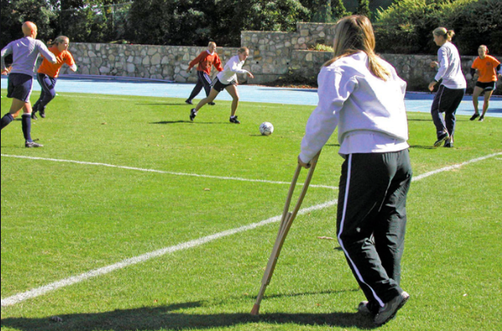 The psychological side of injury is something rarely discussed, and when it is, the discussion occurs in hushed tones or exists on a very superficial level. But it remains, equally if not more important than the physical side. The mind is what gets us to show up every day and put in the work to make the rehab process successful. The mind is what processes the information presented to us and makes a decision on how to respond. Even before we start, we also know that EXPECTATIONS are one of the key predictors of rehab success (if you think you’ll get better, then chances are better that you will!) First, it is important to understand this topic has immense breadth and depth. This isn’t our time to play amateur psychologist (stay in your lane!) but it is essential to appreciate that a rehab approach is incomplete without considering the mind. In the field we often find ourselves uncomfortable with metaphysical concepts we perceive as being pseudoscience “woo-hoo,” sometimes for good reason, but understanding the mind-body connection is also very pragmatic. A knee injury is not just about “ouch my knee hurts.” It might keep you out of work, and potentially without any immediate source of income. It also could mean you have to stop running or walking, which may detach you from your social group. An injury could present a loss of identity if you’re an athlete who then feels invisible when relegated to the sidelines. I remember when Tom Brady suffered a serious injury during a game several years ago, that one of the most jarring moments for him was seeing the team run a play as the game continued on without him while he was driven off. I too experienced this jarring effect as a 12 year old baseball player who was crestfallen upon hearing the news that a knee injury would keep me out of the entire regular season (my way of managing the void was to serve as first base coach on crutches haha). Thanks in part to the resilience of youth, I was able to return for a successful playoff run, albeit while wearing a brace that weighed about as much as me! You may also experience changes in brain chemistry, as your body has grown accustomed to the “high” of the endorphin release associated with exercise. If an injury takes that away, your entire mental state can feel disoriented. Within elite runners, for example, some unpublished research from the USOC has shown that they NEEDED about 10 miles per day to reach the same mood baseline as non-exercisers. As most active people can attest, the very same thing can be true for amateurs. It reminds me of the old adage, when you’re a runner it usually seems like you’re the only person running, but when you’re injured it seems like the rest of the world is running. One recent study of regular exercisers (defined as engaging in moderate exercise at least once per week) found that injured exercisers reported more than twice the level of depression than the non-injured control group (Lichtenstein 2018). The injured exercisers also reported high stress levels, impaired daily functioning and were more likely to have over 10 days injury-related work absence (the latter of which we may speculate could connect with social interaction, finances and/or a sense of purpose, among other things). Fortunately, there are ways to improve these effects. One study of collegiate athletes (Yang 2014) found that injured athletes who were satisfied with the social support received from their athletic training staff were less likely to report symptoms of depression before returning to play compared to those who were dissatisfied with the social support received from the AT staff. Mindfulness training has also been shown to improve mood in patients. There is also evidence from physical therapy research showing that about 40% of patients experiencing depressive symptoms during PT treatment will experience resolution upon successful completion of their PT program. Another strategy is to focus on what you CAN do rather than what you can’t. I often tell patients that if one leg is injured, you still have three uninjured limbs and a torso that are perfectly healthy for high quality training. In fact, the evidence has shown quite clearly that a “spillover” effect exists, in that if you only train one side of the body, some strength gains may carry over to the untrained side. Additionally, use the injury as an opportunity to address areas where you weren’t as strong as you’d like and that you may not have otherwise emphasized. An injury is nothing more than unplanned down time, as legendary running coach Dr. Jack Daniels used to say. Use it as an opportunity to become a more well-rounded with your movement. I’ve had many patients after surgery, return to their surgeon for a follow up and the surgeon is unable to distinguished the repaired limb from the uninjured one! In sum, rather than dwell on what you’ve missed due to injury, embrace the OPPORTUNITY that the situation presents! Everyone’s experience will be different. But we understand that your injury is not just about your injury...The IMPACT on your life can reach much further and deeper, and awareness of this fact by both the patient and the clinician can be a vital element of the rehab process.
0 Comments
 Let me tell you about our patient Ashley… Ashley came to see me just weeks after starting an exercise program. Having turned 30 the previous August, she felt a sense of urgency in her life. Single and childless, the proverbial biological clock loomed in her consciousness. Professionally, life was great in her teaching job. But she knew she needed to make changes to her lifestyle. Having been a casual smoker for years, the first step was to give up smoking and began exercising. Pizza and donuts also gave way to smoothies and salads. So firm was her commitment to change that she began this transformation in December, before the traditional “New Year’s Resolution” crowd. She found a welcoming home at the local Orange Theory and hired a personal trainer. She started craving the endorphin rush of the HIIT training and seeing the progress in her physique. But one day in January she felt an unwelcome twinge beneath her knee. A trip to the doctor confirmed it was a stress fracture, and she was “sentenced” to at least six weeks of limited weight bearing on her injured leg and an even longer time in a knee brace. Over the next several weeks, she was diligently committed to the plan, as an active participant in manual therapy to control pain and swelling, while incorporating strength and mobility training to recover the function she had lost in the weeks of wearing a brace and guarding against pain. But more important than recovering her function was recovering her confidence. Before each session on the treadmill, she required gentle reassurance of what she had already accomplished with ease in prior sessions. With each successful progression, her confidence and trust in her leg grew more robust. Thanks to quick healing, she was soon ready to return to Orange Theory. We had several talks about communicating with the coaches to find alternatives for jumping and running, which eased many of her concerns. Then before her first class back, I received a text from her sitting in the parking lot..”I’m scared :(“ And who in her situation wouldn’t be? If anything, I was proud of her for recognizing her fear and pausing before entering a situation where she didn’t feel comfortable. Fortunately, she only needed a couple reminders of the physical and mental strategies that had worked for her in the clinic. Within minutes, she made a successful return to class and was back on course to living the new life she had envisioned for herself. What can we learn from Ashley? Rehab is not just the physical. Strengthening the body is important, but callousing the mind is vital. Ashley regained her healthy lifestyle by confronting her fears and gaining strength through the daily victories she experienced both inside and outside of the clinic. If you need help reclaiming the active lifestyle that pain and injury have robbed from you, please reach out to Ventana Physiotherapy for a 30 minute Discovery Visit to discuss how we can best serve you. Dr. Allan Phillips Owner, Ventana Physiotherapy 520-306-8093 [email protected] www.ventanapt.physio |
AuthorAllan Phillips, PT, DPT is owner of Ventana Physiotherapy Archives
December 2023
Categories
All
|
2951 N. Swan Rd.
Suite 101, inside Bodywork at Onyx
Tucson, Arizona 85712
Call or Text: (520) 306-8093
[email protected]
Terms of Service (here)
Privacy Policy (here)
Medical disclaimer: All information on this website is intended for instruction and informational purposes only. The authors are not responsible for any harm or injury that may result. Significant injury risk is possible if you do not follow due diligence and seek suitable professional advice about your injury. No guarantees of specific results are expressly made or implied on this website.
Privacy Policy (here)
Medical disclaimer: All information on this website is intended for instruction and informational purposes only. The authors are not responsible for any harm or injury that may result. Significant injury risk is possible if you do not follow due diligence and seek suitable professional advice about your injury. No guarantees of specific results are expressly made or implied on this website.
Proudly powered by Weebly

 RSS Feed
RSS Feed